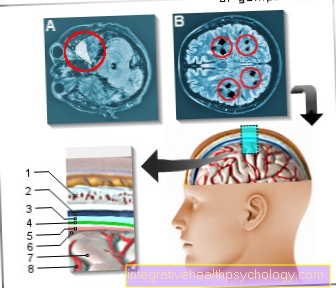Calcification in the prostate
What is calcification in the prostate?
The prostate, also known as the prostate gland, is one of the male reproductive organs. It plays an important role in the production of sperm.
Inflammation or other diseases of the prostate can lead to calcifications in the glands in the course of life. As a rule, it is a deposit of cells or parts of the secretion. In most cases, however, limescale deposits are harmless and do not require treatment.

causes
In most cases, the calcification of the prostate is based on a disease that has subsided, such as an inflammation known as prostatitis. But even a healed prostate abscess, i.e. an encapsulated collection of infected pus, can lead to calcium deposits.
In most cases, the calcification is the result of a deposit of dead cells or dried prostate secretion. In rare cases, benign or malignant prostate cancer can also lead to calcifications.
Read more: Inflammation of the prostate
Inflammation of the prostate
Inflammation of the prostate (prostatitis) can be divided into an acute and a chronic form. It usually arises from a bacterial infection caused by intestinal germs that reach the prostate via the urethra. However, urinary tract infections, urinary obstruction, testicular and epididymal diseases as well as sexual intercourse and urological operations can lead to inflammation of the prostate.
She often goes with a fever, chills, and pelvic pain. In addition, patients often complain of frequent and painful urination (pollakiuria and dysuria). The diagnosis is usually made by a urologist using a blood test and a digital rectal exam. Prostatitis is treated with an antibiotic.
diagnosis
The diagnosis of prostate calcification is made by a urologist. In most cases, calcium is discovered incidentally as a bright white substance during an ultrasound or computed tomography examination.
If the calcifications are so dense that they are deposited as prostate stones, they can possibly also be palpated as small hardenings during a digital rectal examination. The diagnosis can only be confirmed with the help of a CT.
These symptoms show calcification in the prostate
Limescale in the prostate does not cause any symptoms in most cases. If there are symptoms, these are usually the result of another underlying disease. If there is inflammation, there may be a burning sensation when urinating, frequent urination, or pain.
Prostate cancer or very large prostate stones lead to a narrowing of the urethra and thus to a weakened urine stream. Patients also often complain of a constant need to urinate.
How dangerous can that be?
Calcifications are usually harmless. Since they usually do not cause any complaints, they also do not require treatment. They have no tendency to degenerate or ignite. The underlying disease, on the other hand, can be more dangerous.
Both inflammation of the prostate and prostate cancer can lead to serious consequences if left untreated and must therefore be treated.
Treatment / therapy
Since prostate calcifications are harmless, they do not require any therapy. Usually the calcifications are so small that you cannot see them. The risk of surgery would be too great compared to the risk of leaving the calcification in place.
Treatment can only be advised if the calcification is so severe that it causes symptoms.
In addition, there are no drugs that are specifically used for calcification. Only one treatment of the causal disease is required.
How can you remove the calcifications?
There are two ways to remove calcification.
If it is in the inner areas, i.e. near the urethra, it can be removed using a so-called transurethral prostate resection. An electric loop is pushed through the urethra and parts of the prostate tissue are removed.
The second option would be open prostate surgery. However, this is fraught with some risks, so that the sole operation of calcifications is not recommended. If calcifications are discovered during an operation, they are simply cut out. In most cases, however, the entire prostate is removed directly, so that the calcifications no longer play a role.
homeopathy
There are no homeopathic remedies that are specifically used to treat prostate calcifications.
Various substances can help with inflammation of the prostate, for example: Pulsatilla pratensis (pasque flower), Sabal serrulatum (saw palmetto), Selenium amorphum (selenium) or Thuja occidentalis (tree of life).
However, it is not recommended to take it alone to treat inflammation. Each intake should also be discussed in advance with a doctor or pharmacist.
Home remedies
There are no specific home remedies for treating prostate calcification.
Home remedies that are used on the subject of the prostate include, for example: pumpkin seeds, liquorice, nettle, fireweed. In addition, the daily intake of sufficient fluids is recommended.
Any use of home remedies or other medications should be discussed with the doctor beforehand.
Does calcification in the prostate increase PSA?
The prostate-specific antigen is a protein that is produced by the prostate. In the event of illness or manual manipulation, it can be formed more intensely. The normal range is below 1.4 to 4.4 µg / l, depending on age.
Calcifications in the prostate can theoretically increase the PSA value, but usually only slightly, so that it is usually not noticeable. In contrast, diseases such as inflammation, adenomas or malignant tumors lead to a more massive increase in PSA. Therefore, the PSA level in the blood is also used for early diagnosis.
Read more on this topic: PSA value
Duration / forecast
Calcification in the prostate can persist for several years. As a rule, the tendency for calcium deposits to build up increases with age due to more frequent inflammation or tumors. Since calcifications are usually harmless and do not lead to any symptoms, they are often not discovered for years and are often only diagnosed as an incidental finding.
However, life expectancy does not change with the appearance of lime.





























